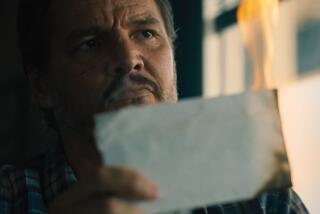MOVIE REVIEW : ‘Shakes’ Stumbles Over Unnecessary Plot Twists
- Share via
If you’re going to be a rebel, it’s best to go all the way. In “Shakes the Clown,” (citywide), writer-director-star Bobcat Goldthwait has a subversive premise with lots of potential. But he muffs it. He keeps cutting to the chase, when the chase is the least interesting part of his movie.
In “Shakes,” Goldthwait wants to show us the dark side of clowning, the sleazy underbelly of American media sweetness and light. His central image--white-faced clowns with red-bulb noses sitting around a dingy barroom in full makeup, spouting obscenities and cynical cracks--mixes up the iconography of “The Iceman Cometh” with “Dumbo.” It’s as if the cast of “Bozo’s World” suddenly wandered into the splayed-light barrooms of “Fat City.”
Potentially, it’s a rich collision. Goldthwait’s clowns--especially his own role, the alcoholic Shakes--are a metaphor for all entertainers trapped in phonily upbeat conventions. Staggering drunkenly from kids’ party to kids’ party, tanking himself up in the last minute, Shakes is Booze-o the Clown. There are five or 10 o’clock shadows under the clown white, straggly sweaty hair under the frizzy orange wigs. Back at the bar, his buddies howl “Smoooth!” just like Red Skelton hawking Guzzler’s Gin.
Goldthwait couldn’t peddle this notion to the major studios, and it’s no wonder. Boozey, drugged-out clowns is the image insider types don’t want the public to see. But Goldthwait has always straddled two worlds. An anti-Establishment comic who hit big in extremely mainstream movies, playing the strangle-voiced slob Zed in the “Police Academy” series, he may have sold out in ways he doesn’t quite realize. Here, he’s letting big studio script-forms bend his ideas.
What goes wrong in “Shakes the Clown” isn’t the central notion or the performances. Most of the acting has both the virtues and vices of loosey-goosey improvisation; Goldthwait himself is strangely endearing in his Shakes makeup.
But much of the plot is strictly High Concept action-comedy. A hero and his buddies battle snobs and bullies. A villain--old Goldthwait partner Tom Kenny as Binky, a disco clown in Joker makeup--murders, snorts coke and steals his job. There are car chases, crashes, gunfights.
And, by the end, we have one more girlfriend (Julie Brown’s Judy) facing death. None of this has any conviction; Goldthwait neither relishes the conventions nor sends them up. It’s high-concept jive and it gets in the way of both the jokes and the pain that feeds them.
Toward the end, Robin Williams, billed in the credits as Marty Fromage, and playing Mime Jerry, gives “Shakes” its funniest scene. Palms pressed against imaginary glass or kitty-clawing the air, tartly instructing the slovenly Shakes--who was previously an unregenerate “mime-basher”--Williams’ moves are feline-slick. He’s like a live-wire mix of Franklin Pangborn and Marcel Marceau. He’s willed himself into the whole imaginary social structure here: with its slob proletarian clowns, squeaky-rich yuppie families, gay aesthete mimes, disco-druggie sellouts and bumbling cops.
Goldthwait has his world figured out, but he doesn’t have the movie to put into it. Or rather, he’s putting someone else’s movie into it, a movie we’ve all seen before. “Shakes the Clown” (MPAA-rated R for language, drug use) may seem distasteful to clown iconographers. But it works when it’s incongruous, creepy and a little nasty, when it lets some blood and sweat spill out over the greasepaint. It fails when Goldthwait snaps to and remembers he’s making films, that certain conventions have to be observed. No they don’t, Shakes.
‘Shakes the Clown’
Shakes the Clown: Bobcat Goldthwait
Judy: Julie Brown
Binky the Clown: Tom Kenny
Owen Cheese: Paul Dooley
An I.R.S. Releasing presentation of an I.R.S. Media production. Director/screenplay Bobcat Goldthwait. Producer Paul Colichman. Executive producers Miles A. Copeland III, Barry Krost, Harold Welb. Cinematographers Elliot Davis, Bobby Bukowski. Editor J. Kathleen Gibson. Costumes Stephen M. Chudej. Music Tom Scott. Production design Pamela Woodbridge. Art director Christopher B. Neeley. Running time: 1 hour, 26 minutes.
MPAA-rated R (Language, drug use.)
More to Read
Only good movies
Get the Indie Focus newsletter, Mark Olsen's weekly guide to the world of cinema.
You may occasionally receive promotional content from the Los Angeles Times.







